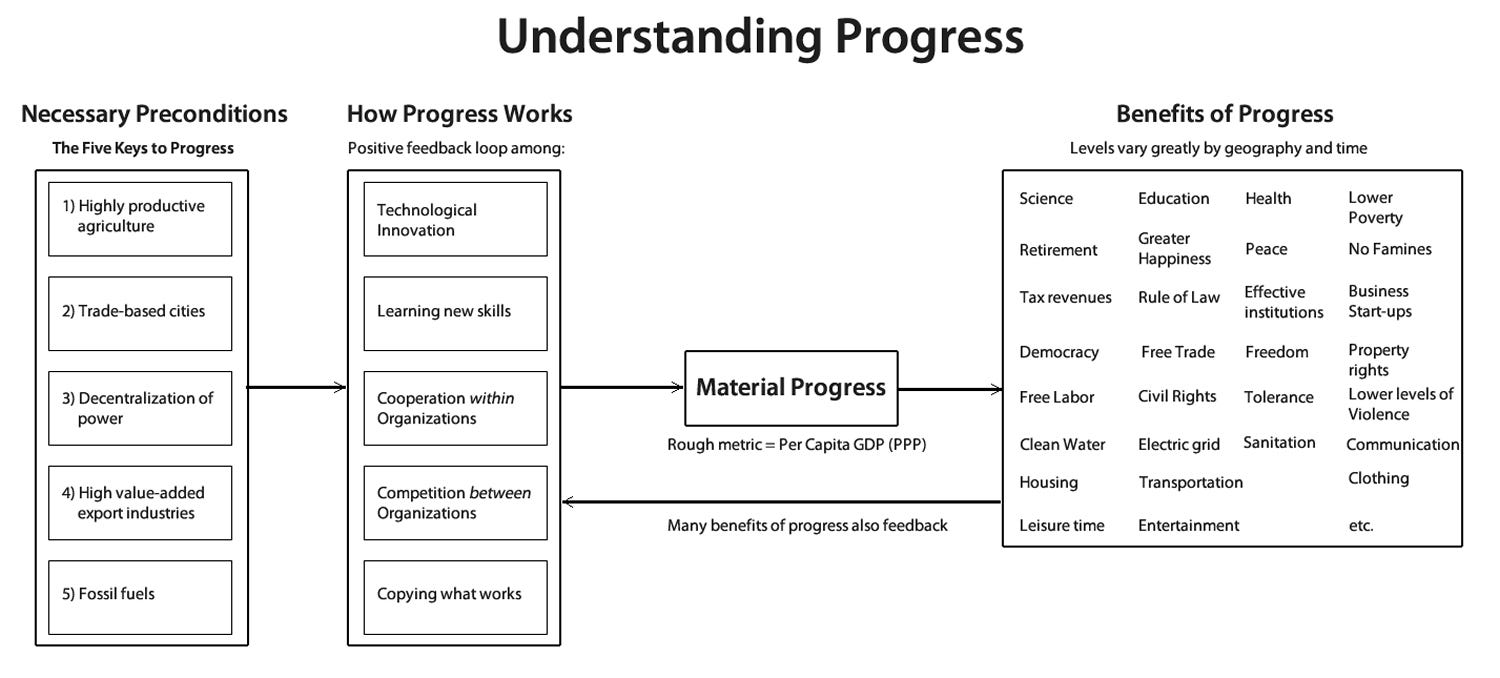Make someone’s day: Gift a subscription to your friends and family!
I am fascinated by how individuals and organizations learn and get things done. Fortunately, I had a career as a User Experience Designer that enabled me to see in inner workings of dozens of different corporations in a wide variety of business sectors. It never failed to amaze me how different a culture each corporation was.
But underneath the differences were some key similarities that helped me understand How Progress Works. As a reminder, I believe that once a society establishes the Five Keys to Progress, material progress naturally flows from the positive feedback loop among the following:
Technological innovation. This includes radical innovations such as the railroad, electrical grid, computers, and the internet, as well as the ongoing incremental improvement and differentiation of thousands of other existing technologies.
People learning new skills to support those technologies. Without these skills, technologies are not useful, a fact that is often forgotten.
People cooperating within organizations. Those people work together using a wide variety of skills and technologies to accomplish a common goal.
Competition between organizations for scarce resources. In the past, this was usually food, while now it is usually revenue. This competition forces organizations to embrace new technologies, skills, and processes to out-compete other organizations. It also forces people within the group to cooperate more closely, and enables new organizations to be founded and older organizations to fail.
People copying successful technologies, skills, and organizations and then modifying them to solve different problems. This enables innovations that work to spread into new companies, new sectors of the economy, and new geographical regions. This step is critical to ensure that progress is widely shared.
Consumption of vast amounts of useful energy. Without energy, none of this can happen. Today the vast majority of that energy comes from fossil fuels.
This post more fully explores the fifth (copying). I believe that it is the most neglected factor in How Progress Works.
The following is an excerpt from my book From Poverty to Progress: Understanding Humanity’s Greatest Achievement. You can purchase discounted copies of my book at my website, or pay full prize at Amazon.
Other books in my “From Poverty to Progress” book series:
Innovation Is Local and Unequal
I believe that human material progress is best understood as an evolutionary process. Innovations evolve and then gradually spread to other regions. Understanding how innovations occur and how they spread is essential to Progress Studies.
Innovations are local in nature. By this, I mean that the solutions evolve to solve local problems within their unique environment. Those solutions are not designed to solve all problems for all of humanity. Those solutions may be highly applicable to others, but that is not their original intention.
In addition, because the first instance of a solution is by definition located in one specific geographical area, it does not automatically spread to the rest of the world. The result is that evolutionary processes are inherently unequal.
An innovation made in Amsterdam, for example, does not automatically spread to the rest of the planet. So for at least some portion of time, Amsterdam (or at least a few people within Amsterdam) has technology that no one else does.
Because a larger number of technologies leads to a greater number of innovations, this process feeds upon itself. Areas that have local environments conducive to innovation create more technologies, which make additional innovations possible. For this reason, in any given period there tends to be a very small number of centers of innovation that give birth to the lion’s share of total innovations.
This means that, as long as those areas can maintain those characteristics that enable technological innovation, the innovation keeps feeding upon itself. This increasingly differentiates those few areas from the other human societies that have evolved in regions that were less conducive to innovation.
Innovations Can Be Copied
If those were the only factors that influenced innovations, then we would be stuck with a few very wealthy and innovative areas and the rest of the world would be poor and stagnant. Fortunately, there is one characteristic of human behavior that enables the innovations of a few centers to spread more broadly; it is the ability of humans to copy other humans.
Humans can:
see a technology or skill being used by another person,
identify its purpose,
assess its usefulness compared to their own toolkit and then
decide to copy it.
While other animals may have this skill (young birds and mammals learn from their mother), the human species has taken this to a new level. This means that humans from some societies can enjoy the benefits of innovations created by other societies.
There are real benefits to being the copier rather than the innovator. The innovator has to go through all the hard work of:
designing a new piece of technology,
testing it and
iterating on the results.
The innovator also has to go through the hard work of:
learning all the necessary new skills related to that technology.
invested the time to learn how to adapt their social organizations on how best to use those technologies.
The copier can just wait, watch the results, and copy only when it looks like the original innovators have come up with a superior solution.
Copying Is Not So Easy
Unfortunately, copying is not as easy as it sounds. To copy a new technology, a society must have certain characteristics. It is very difficult to learn a new skill entirely from scratch. It is much easier if one already has skills that are related to the new skills.
For example, it is much easier for a fisherman to learn skills related to fishing. A fisherman who is skilled in fishing with a hook and line would probably be able to learn how to fish with nets fairly quickly. The two skills are fairly closely related.
But it would be very difficult for that fisherman to learn quality assurance testing of software, as the two skills have very little in common. Without being able to interact directly with experienced Quality Assurance testers, it seems highly unlikely that a fisherman would ever learn the skill with sufficient productivity to become an effective worker.
And even if this was a very talented fisherman who somehow learned the intricacies of software testing, what good would it do? Without being in close geographical proximity to other people with other skills related to software technology, his new skill would not do him much good.
Someone else in the village would need to learn how to code software, another would need to learn to market that software and another would need to sell that software. As each necessary new skill is added, the odds that a random group of people can learn them rapidly diminish.
Now, let us just assume that this is an extraordinarily talented group of fishermen. They somehow teach themselves all of the skills necessary to produce and sell a new piece of digital technology. It is very unlikely that the fishing village has a software company that could hire them.
In theory, all of the fishermen could band together to form their own company, but then they would have to learn all the processes (the ways that persons of differing skills cooperate to produce and sell a technology) on their own. They would also need to acquire all the technologies required to build and test software. Plus they would have to acquire the relationships with customers that companies typically possess.
Now, let us assume that our group of people who want to learn is instead an existing software company. The software company learns about a new type of software that a rival company has created. The software company will still have much to learn to effectively copy their rivals’ products, but because they already possess technologies, skills, and processes for similar software, they have a real chance of being able to copy with much less investment of time and resources than the original innovator.
This leads to an important insight: the conditions that are necessary to copy technology are very similar to the conditions that are necessary to innovate technology. If a society has the proper conditions, it will be able to innovate and copy the innovations of others at a far more rapid rate than other societies.
If the rate of innovation is fast enough that people see the benefits of working, innovating and copying the innovations of others rather than seeking to extract wealth from others via military conquest or expropriations, then progress can result. As long as these conditions remain in effect, it becomes a self-sustaining process.
In the final article in this series, I explain the importance of consumption of vast amounts of useful energy. Without energy, none of this can happen.
The above is an excerpt from my book From Poverty to Progress: Understanding Humanity’s Greatest Achievement. You can order e-books at a discounted price at my website, or you can purchase full-price ebooks, paperback, or hardcovers on Amazon.
Other books in my “From Poverty to Progress” book series:
You can learn more about How Progress Works with these links:
People learning new skills to support those technologies.
Competition between organizations for scarce resources.
People copying successful technologies, skills, and organizations and then modifying them to solve different problems. (this article)
Consumption of vast amounts of useful energy.











I must ask, since if you are in favour of copying- what are your thoughts on intellectual property?